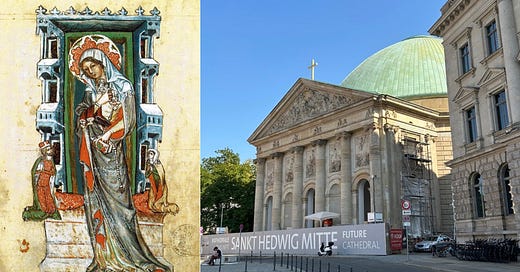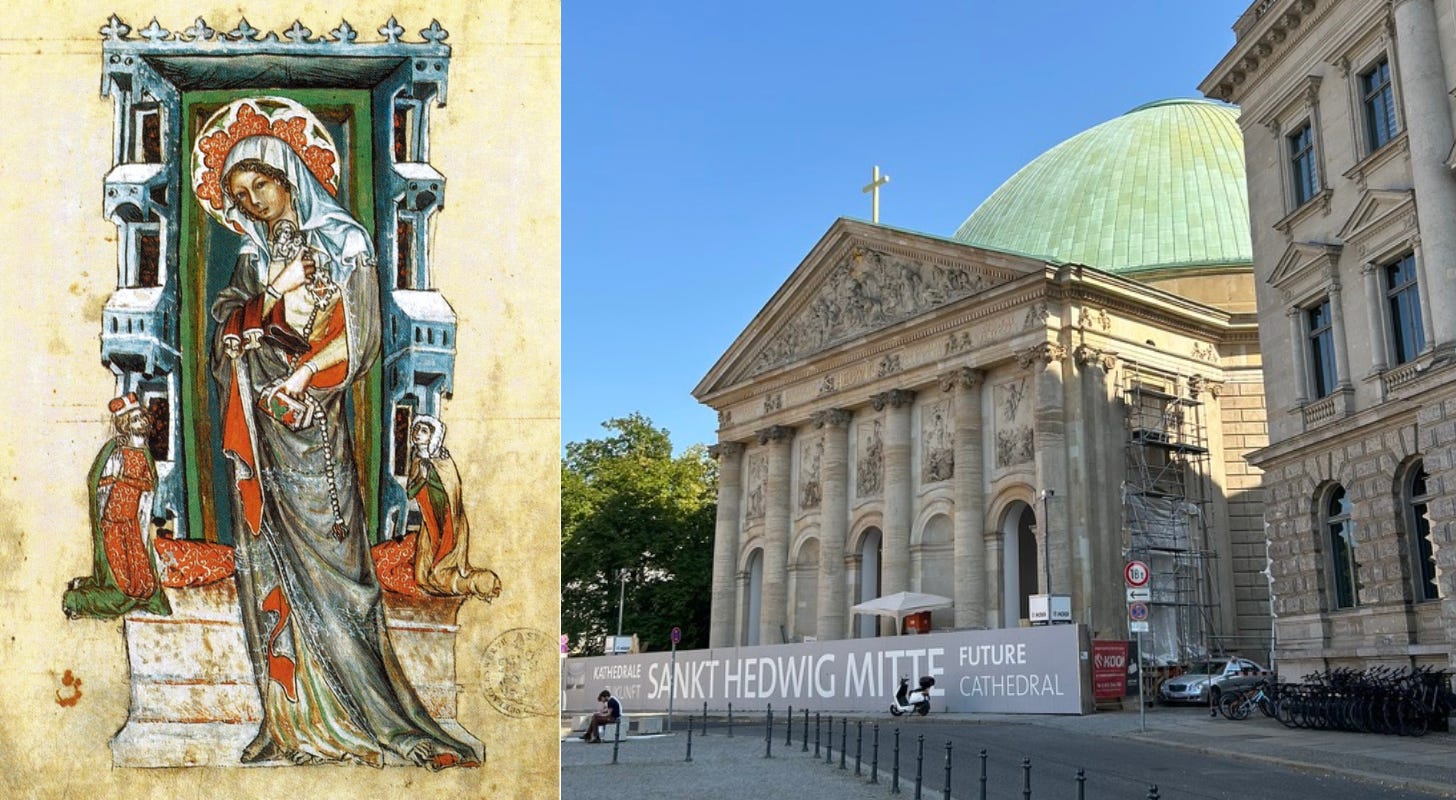🌹🎶 Roses of Berlin - 2: Two Saints & A Goddess
The second in a series of rambles about Women of Berlin
🌹🎶 Roses of Berlin
A series of rambles about Women of Berlin
Wandering the streets of Berlin this September, I wondered at the tales and trails left by women who changed the course of the city and herstory. We’ll be meeting everyday heroines, pious saints, dynastic Queens and political activists as I share weekly posts about my discoveries. Having met the brave women of Rosenstraße, this week we find three ethereal women presiding over the fates and fortunes of Berlin.
2. Two Saints & A Goddess
The luminous melon dome of St Hedwig’s Cathedral looms over a square alongside Berlin’s grand architectural catwalk, Unter der Linden. The first linden was reportedly planted by Sophie Dorothea (1636 - 1689) as part of Dorotheenstadt, a wedding gift of land from her husband Frederick William the Great Elector (1636-1688). In 1747 their great-grandson Frederick the Great, set about building his grand design for Berlin, the Forum Fredericanum, centred on new square alongside Unter der Linden.
Originally named Opernplatz after the Opera House and the site of Goebbels infamous book burning in 1933, the square was renamed Bebelplatz after Socialist Democrat leader August Bebel in 1940. Amongst many works consigned to flames as ‘degenerate’ were those of socialist suffragist Helen Keller (1880–1968) who defied censorship in her Open Letter to German Students:
“You may burn my books and the books of the best minds in Europe, but the ideas those books contain have passed through millions of channels and will go on.”
Today the prophetic words of Jewish writer Heinrich Heine (1797-1898), also torched in the book burning, are inscribed on a memorial at Bebelplatz:
Das war ein Vorspiel nur, dort, wo man Bücher Verbrennt,
verbrennt man auch am Ende Menschen.
That was only a prelude. Where they burn books, they will, in the end, burn human beings too. - Heinrich Heine - Almansor, 1821
Hedwig is nestled in a corner of Bebelplatz, her story told on hoardings whilst the Cathedral is closed for renovation. Born to German-Bavarian aristocracy and married off at age 12 to Henry I the Bearded of Silesia (in modern-day Poland), Hedwig of Andechs (1174-1243) was seen as a peace builder. After having seven children, including the wonderfully named Konrad the Curly, Hedwig and Henry decided that was enough and took a vow of celibacy. Hedwig dedicated herself to building, living and working in convents and hospitals. Her good works included giving a castle to the poor and advocating against the death penalty, whilst living a pious simple life and walking barefoot. Canonised in 1267, her Saints Day is celebrated on October 16th.
As Frederick the Great had conquered Silesia in 1742, Hedwig was called in once again to build bridges. Completed in 1773, St Hedwig’s Cathedral was the first Catholic Cathedral in Berlin since the Reformation, becoming a symbol of religious tolerance. Inspired by that same spirit, Father Bernard Lichtenberg, who became canon of the cathedral in 1931, courageously prayed for the Jews after Kristallnacht in 1938, warning “The synagogue outside is burning, and that is also a house of God!” Having protested the Nazi euthanasia programme and treatment of the Jews, he was dubbed the “gutter priest from Berlin" by SS second-in-command Reinhard Heydrich and died of pneumonia whilst being deported to Dachau in 1943. Only a shell of Hedwig’s Cathedral of Tolerance remained after World War II - having been restored and reopened in 1952, she is now undergoing another transformation.
Saint Gertrude - a revered medieval cat-lady/ Berlin sculpture
Tired and dusty at the end of a day of rambling around Berlin, I was dazzled by the apparition of Heilige Gertraude / Saint Gertrude, patron saint of travellers, towering over Gertraudenbrücke. Rudolf Siemering’s 1896 bronze sculpture depicts her administering water to a ‘travelling scholar,’ whilst mice and rats flee at her feet earning her the title of plague protectress and medieval cat-lady. After narrowly escaping being melted down for arms in World War II, Gertrude emerged from hiding and was restored to her rightful position in 1954.
The original Gertrude of Nivelles (c.62 -659), daughter of Frank nobles Pepin and Itta of Landen, also had to flee avaricious men. According to her biography, Vita Sanctae Geretrudis, she vehemently refused her first political marriage match at age 10, declaring she would have no spouse but Christ, the only acceptable get-out clause for medieval women. Surrounded by threats of marriage and abduction after Pepin’s death, Itta shaved her daughter’s head into a monk’s tonsure and established a monastery in Nivelles where they could both live safely. As an Abbess Gertrude was renowned for her care of the sick, poor and elderly and her hospitality towards travellers, in particular Irish monks. After Gertrude miraculously appeared and saved one such monk from trouble at sea, travellers raised a Gertrudenminne before embarking on journeys. The Getrudenkirche in Osnabrück stands on the site of St Gertrude’s monastery which administered home-brewed beer to female pilgrims. Eschewing grandeur in life and death, Gertrude was buried in her hair shirt and a pilgrim’s veil on 17th March, earning her the devotion of spring-time gardeners.
Today Gertrude presides over a hospital in Berlin-Wilmersdorf, founded in 1930 by the Katharinenschwestern, a Roman Catholic Women’s Order. Run as a military hospital by 120 sisters during World War II, today Sankt Gertrauden Hospital has 364 beds and 1000 staff, serving 20,000 patients annually. St. Hedwig likewise oversees a hospital founded by the Catholic Borromäerinnen sisters in 1846, who in the spirit of tolerance welcomed all patients regardless of religious or cultural background.
The view from - and through - Gertraudenbrücke, where lovers leave engraved padlocks.
Symbol of Berlin’s trauma and triumph, Victoria, Goddess of Victory rides her quadriga chariot atop the famed Brandenburg Gate crowning Dorothea’s Unter der Linden. Originally designated Eirene, Goddess of Peace by sculptor Johann Gottfried Schadow in 1793, she has been draped with communist and fascist flags, and decorated with olive branches and the Prussian Iron Cross. Exiled to Paris by ‘Horse Thief’ Napoleon after his 1806 occupation of Berlin and isolated by Die Mauer / The Wall in 1961, she has known both freedom and captivity. The voices of international leaders including J.F.Kennedy, Gorbachev, Merkhel, Reagan and Obama have whistled around her chariot wheels. In celebration of reunification, she was serenaded with Beethoven’s Ode to Joy by Berlin Philharmonie in 1989. Like her saintly sisters, Berlin’s Goddess has fallen and risen with her city - reclaimed as a symbol of peace and unity, she rides towards an unknown future.









